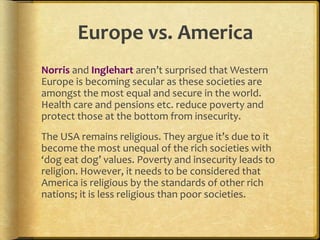The religious market theory proposed by Stark and Bainbridge argues that religion behaves like a market, with demand for religion remaining constant but demand for specific religions varying. They believe secularization theory overlooks religious revival cycles.
Norris and Inglehart propose the existential security theory, arguing that variation in religiosity is better explained by differences in levels of existential security - the feeling of survival being secure. Religiosity is higher in societies with more insecurity due to factors like poverty, disease, and inequality, and lower in wealthy societies with strong welfare states that reduce insecurity.















